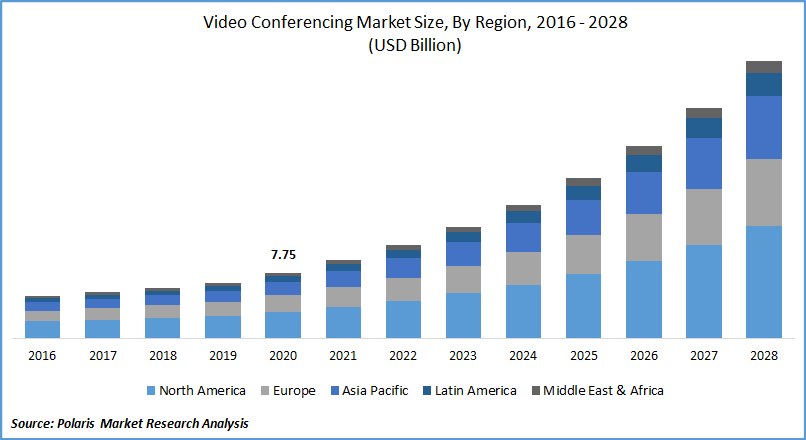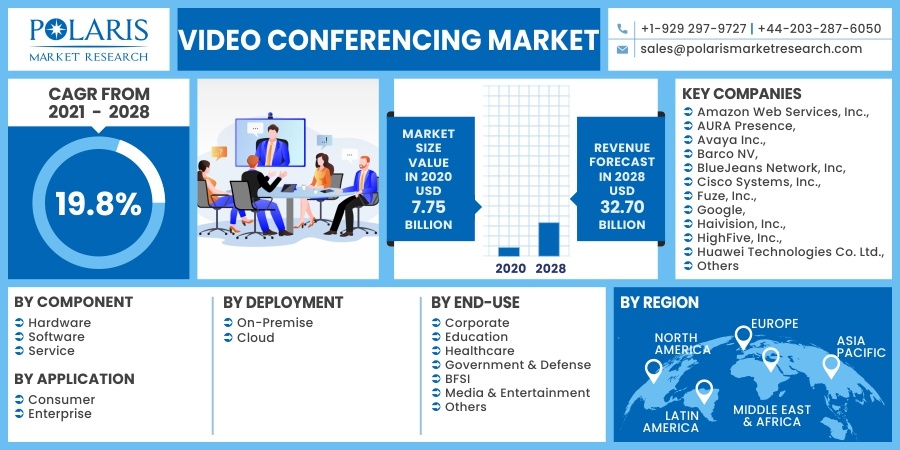
Video Conferencing Market Share, Size, Trends, Industry Analysis Report, By Component (Hardware, Software, Service); By Deployment (On-Premise, Cloud); By Application (Consumer, Enterprise); By End-Use; By Region; Segment Forecast, 2021 - 2028
- Published Date:Oct-2021
- Pages: 123
- Format: PDF
- Report ID: PM2038
- Base Year: 2020
- Historical Data: 2016 - 2019
Report Outlook
The global video conferencing market size was valued at USD 7.75 billion in 2020. The video conferencing industry is projected to USD 32.70 billion by 2028, exhibiting a CAGR of 19.8% during 2021- 2028.
The growth of this market is driven by the surge in innovations in the field of video conferencing, coupled with the robust market growth in penetration of video conferencing solutions in the education and telemedicine sectors, which is now required to optimize the utilization of the collaboration platform and increase the efficiency of meetings by integrating virtual assistant technology.
 Know more about this report: request for sample pages
Know more about this report: request for sample pages
Furthermore, the rising need for operational enterprise communication along with large-scale investment by several organizations for modernizing and simplifying communication networks is further expanding the implementation of video conferencing globally. The outbreak of the COVID-19 pandemic is sweeping all over the world, tapping countries, communities, and societies under enormous pressure. Globally, governments from the different geographic regions have enforced stringent lockdowns and social distancing policies to control or mitigate the spread of novel coronavirus, which are now widely acknowledged as the most effective way to combat the pandemic.
As a result, the pandemic leads to the cancellation of different corporate events, including trade shows, product launches, international seminars, investors presentations, and more. This, in turn, has forced the organization and government agencies to use video conferencing solutions, such as Zoom, Microsoft Teams, and more. For instance, in April 2020, the Indian Supreme Court published a notice to the regional courts to manage the judgments through video conferencing, which has positively impacted the video conferencing market growth.
Video conferencing is a technology that allows users in distinct locations to hold face-to-face meetings deprived of the requirement to move to a single place together. The technology is often considered convenient for business users in several countries as it saves expenses, time, and aggravations regarding business travel. Furthermore, the use of video conferencing, such as to conduct routine meetings, assign business deals, and hold job interviews of candidates, eventually paving the way for higher market growth during the forecast period.

Know more about this report: request for sample pages
Industry Dynamics
Growth Drivers
The proliferation of the video conferencing market is rising at a significant pace rate considering the global scenario. With the rapid shift in preference for video conferencing interviews in the recruitment process, video conferencing technology has become a viable option to strengthen its brand by hiring candidates with exceptional professional skills. Conferencing enables business organizations to gain insights regarding the aspects, including the ideal meeting length, the optimal number of participants, and more.
Conferencing is also helping organizations to find and analyze better content of meeting at a faster pace and with more ease and effectiveness by modernizing and simplifying the business process. Hence, video conferencing is becoming the standard practice and appeals a comparative analysis among meetings in an organization, which, in turn, strengthens the trend for video conferencing in developed and emerging markets.
This accelerating demand for cloud technology on the back of the digital age has insisted enterprises replace to deploy cloud-based solutions by replacing traditional systems of the business management process. Thus, global companies are looking forward to integrating cloud-based video conferencing solutions and services and playing a critical role in changing the dynamics of the video conferencing market during the forecast period.
Report Segmentation
The market is primarily segmented on the basis of component, deployment, application, end-use, and region.
|
By Component |
By Deployment |
By Application |
By End-Use |
By Region |
|
|
|
|
|
Know more about this report: request for sample pages
Insight by Component
Among the component segment, the hardware segment held the largest stake in the global market in 2020. The market growth of the hardware segment can be attributed to the growing development and acceptance of endpoints, including smartphones, laptops, and desktops fortified with high-resolution cameras, speakers, and microphones. In addition, the rise in adoption of the Internet of Things (IoT), enabling the robust incorporation of hardware with cloud-based software solutions and other key technologies, such as artificial intelligence and facial recognition, are the few factors that boost the market growth.
The service segment is likely to propagate at an effective rate during the foreseen period, owing to the escalating integration of augmented reality and other key technologies and cloud-based video conferencing services, such as Adobe Connect, LoopUp, and so on, which is likely to enhance customer experience. Moreover, a significant increase in mobility needs of remote workforce and workers has been witnessed, which would further complement the market growth of this segment worldwide.
Insight by End-Use
The corporate segment is expected to see a large revenue in the global market, owing to the rapid development of the cloud-based collaboration and communication software industry, opening new opportunities for new players in the marketplace. Further, the continual growth in the frequency of geographically dispersed teams has promoted the massive utilization of cloud-based platforms to streamline business processes, enhance productivity, and manage projects of all extents, accelerating market growth.
On the flip side, the healthcare segment is expected to pave a high market share in terms of revenue by 2028. It helps healthcare providers in patient care and telemedicine, healthcare administration applications, and medical education to deliver improved patient care by offering them enhanced communication options. Thus, these factors are expected to contribute to the market growth fortune.
Geographic Overview
Geographically, North America dominated the global market due to the robust growth and early adoption of advanced technologies and software associated with video conferencing in the region. Additionally, the escalating demand for continuous access to high-quality visual meetings and the internet, coupled with the increasing popularity of Bring Your Own Device (BYOD) solution, is further expanding the market growth at a rapid pace considering the global scenario.
Additionally, countries such as the U.S and Canada are further estimated to register the largest number of initiatives, and partnership agreements will prolong unified communication (UC) solutions and video conferencing collaboration portfolio to streamline businesses of several sizes across these countries. As a result, to which in January 2020, U.S.-based Lifesize, Inc. completed the partnership with Tech Data to offer video conferencing services in remote areas of New Zealand and South Korea more effectively, which is expected to bolster the market growth.
Moreover, Asia Pacific is expected to observe a high CAGR in the global market in 2020. The demand for video conferencing in the region is anticipated to increase over the forecast period, owing to the extensive usage of technologies, including cloud computing, IoT, and AI to effectively manage connected devices, coupled with the huge proliferation of 4G and 5G networks that present huge opportunities for the acceptance of the video conferencing.
Competitive Landscape
Some of the Major Players operating the global market include Amazon Web Services, Inc., AURA Presence, Avaya Inc., Barco NV, BlueJeans Network, Inc, Cisco Systems, Inc., Fuze, Inc., Google, Haivision, Inc., HighFive, Inc., Huawei Technologies Co. Ltd., Kaltura, Inc., Kollective Technology, Inc., Lifesize, Inc., Logitech International S.A., LogMeIn, Inc., Microsoft Corporation, Pexip, AS, Plantronics, Inc., Qumu Corporation, Sonic Foundry, Inc., StarLeaf Inc., Vidyo, Inc., and Zoom Video Communications, Inc.
Recent Development
- March 2024: Zoom Workplace unveiled an AI-powered collaboration platform to reimagine teamwork. According to Zoom, this technology ensures a seamless AI deployed workforce in an economical way. Also, it provides a seamless way for colleagues and customers to connect and achieve their daily objectives more productively.
- March 2024: Microsoft and Oracle expanded their partnership to satisfy global demand for Oracle Database@Azure worldwide. For Microsoft, this merger with Oracle will make the migration of workloads streamlined and also empower business innovation.
Video Conferencing Market Report Scope
|
Report Attributes |
Details |
|
Market size value in 2020 |
USD 7.75 billion |
|
Revenue forecast in 2028 |
USD 32.70 billion |
|
CAGR |
19.8% from 2021 - 2028 |
|
Base year |
2020 |
|
Historical data |
2016 - 2016 |
|
Forecast period |
2021 - 2028 |
|
Quantitative units |
Revenue in USD billion and CAGR from 2021 to 2028 |
|
Segments covered |
By Component, By Deployment, By Application, By End-Use, By Region |
|
Regional scope |
North America, Europe, Asia Pacific, Latin America, Middle East & Africa |
|
Key Companies |
Amazon Web Services, Inc., AURA Presence, Avaya Inc., Barco NV, BlueJeans Network, Inc, Cisco Systems, Inc., Fuze, Inc., Google, Haivision, Inc., HighFive, Inc., Huawei Technologies Co. Ltd., Kaltura, Inc., Kollective Technology, Inc., Lifesize, Inc., Logitech International S.A., LogMeIn, Inc., Microsoft Corporation, Pexip, AS, Plantronics, Inc., Qumu Corporation, Sonic Foundry, Inc., StarLeaf Inc., Vidyo, Inc., and Zoom Video Communications, Inc. |
